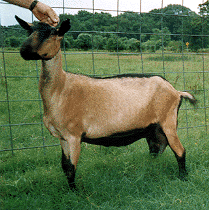|

You may need:
- bleach water for soaking tough
feet hoof
- shears or garden pruning shears
- horse hoof pick
- Koppertox or other hoof rot ointment
- small wood planing tool
- blood stop powder or at least cornstarch
Good routine hoof care
is far more preferential than a quarterly or semiannually trim.
If they are allowed to grow, they can split or get brittle, cracking
up into the quick and causing soreness and infection. They can
collect small stones and are more of a contained moist area for
hoof rot to occur.
A heavily pregnant doe
is reluctant to stand for very long on three legs, so the faster
you can cut the new growth off, the easier on both yourself and
the goat. The 'hoof rot shears' sold by caprine supply and other
supply houses were the standard for many years. In the last 5
years, the gardening or pruning clippers have become popular.
These have a bright orange handle and thin blades coated with
teflon. Whatever pair you decide to get, make sure the cutting
blade is thin and short, and that both sides of the scissors have
a cutting edge. Often gardening or pruning shears will have a
cutting edge that hits a blunt platform to make the cut. These
won't work for hoof clippers. I've
seen a nice tool made from a carpet blade and I also use a knife
with both sides of the blade sharpened. This pares off both sides
of the toe in one motion, and is good for routine hoof maintenance.
So, use whatever you feel most comfortable with, and what works
for you.
You'll also want to invest
in a small Stanley wood plane to rasp off all the burrs and rocky
edges you've created. The plane is used as a final step to level
and blunt the edges after the hoof has had as much excess growth
trimmed off as possible.
Pick up the hoof and
pick out any small stones and hay or manure. The tip of the clippers
is fine for this but you may be more comfortable using a blunt
horse hoof pick.
To make the actual cut:
Work from the heel to the toe, trimming the overgrown hoof as
closely to the pad as possible. You'll probably have to make several
cuts to get it to the level needed. Leave the toe somewhat longer
than you might think to help preserve the look of balance, and
actually, help to prevent new growth from turning under the foot.
Once you get familiar with the way a goat hoof grows, you can
actually do a little orthopedic trimming to help correct the legs
and gait of some animals. By taking more off the heel, you can
shorten the pasterns on an animal that may have slightly fallen
pasterns. If they toe out or in, you can adjust somewhat by trimming
more off one side than the other. Basic major faults, lobster
toes, cow hocked, etc, can not and should not be corrected by
simple hoof trimming. These and some others are heridity traits
and should be held under consideration when the animal is paired
for breeding.
Goats that have been
left for a bit longer than desirable will have to have their feet
trimmed in stages. The tender quick needs to be allowed time to
recede or you could easily cut into it. If you do, don't panic,
we've all done it, and the amount of bleeding is alarming, but
usually harmless. Have some blood stop powder handy or even cornstarch
will work to staunch the hoof cut. You HAVE made the foot sore,
so expect the goat to favor that hoof for a few days. Small stone
bruises in the pad itself can often be trimmed completely away
without affecting the goat at all. (In horses, this pad is called
the frog.) If the pad has had material pressed against it for
any length of time, it'll develop hoof rot fairly easily. If you
notice any odor at all while working on the feet, an ointment
called KopperTox can be applied to aid hoof rot conditions, after
the manicure. Generally, keeping the feet dry and cleaned out
of any foreign material will be the best solution possible.
Beware of old wives tales!
I've heard several 'explanations' of why an owner has not trimmed
feet in an alarmingly long time. "The extra hoof keeps the goat
off the cold ground in the wintertime," "She was so pregnant,
I didn't want to make her stand on 3 legs." "I like to see how
long their toes grow, it is a good indication of milk capacity."
(?) "She's so fat and lazy, she ALWAYS walks on her knees!" I'm
sure you've heard others just as bizarre. If you plan to purchase
a new goat, look closely at the whole herd. If many or most of
them have poor feet, chances are the owner is careless with the
rest of their management also. If a number of them are limping,
a giveaway that emergency hoof trimming was attempted prior to
the sale. This would not keep me from purchase, but I'd be hesitant
to believe anything about the goats other than my own observations.
Take advantage of wet pastures and rainy weather by routine maintenance
on your herd's feet. If I have a disagreeable task waiting on
me elsewhere, my goat's feet must be tended to first!
Text
and images copyright 1998 Martha Wells
|